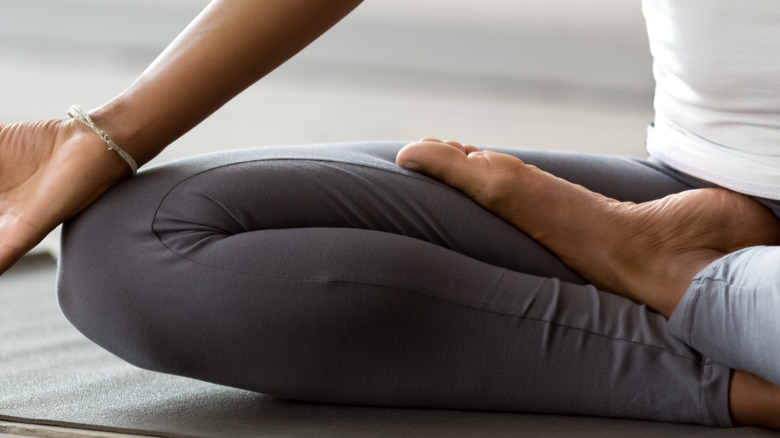What Happens To Your Body When You Stop Wearing Leggings
Leggings are a staple clothing item for many women. Once only used during workouts like yoga, leggings are now acceptable to wear to parties, lunch dates, and more. This versatile clothing piece can do no wrong. Or can it? According to The Healthy, your leggings may actually be the culprit behind various skin and health issues.
Tight leggings can rub against your skin and cause chafing. This is more likely to happen when you wear clothes made of cheap materials, but even the most expensive leggings can cause chafing. If you experience chafing from wearing leggings, there are a few ways you can treat your symptoms. Clean the chafed area and keep it dry, as moisture can make you more uncomfortable (via WebMD). After cleaning, you should apply a moisturizing treatment that also acts as a barrier on your skin, such as petroleum jelly. Avoid wearing clothing that will rub against that area of skin until it has fully healed. When you stop wearing leggings, you may notice an improvement in the moisture and texture of your skin.
How leggings can cause fungal infections
Leggings can also lead to folliculitis, which refers to inflammation in the hair follicles. Folliculitis is typically caused by bacterial or fungal infections that will only clear up when the area of cleaned regularly and given room to breathe. Smothering a fungal infection with a tight pair of leggings will just make it worse. If you notice small red bumps on your legs, give your leggings a break for a few days. Folliculitis often requires medication to be successfully treated, including antibiotics or antifungal creams.
Another fungal infection that can be caused by leggings is ringworm (via Cosmopolitan). Ringworm is a contagious infection that gets its name from the circular shape of the rash it produces. The fungus that causes ringworm thrives in warm, moist environments, which is exactly what leggings provide. If you think you might have ringworm, it's important to see a doctor so you can get treatment. Jock itch is another fungal infection that thrives in warm, moist environments. While it's more commonly seen in men, women can get it too (via Healthline). Jock itch is characterized by a red, itchy rash that usually affects the inner thighs, buttocks, and groin. Wearing leggings that are tight and don't allow your skin to breathe can increase your risk of developing jock itch. Your risk of developing these fungal infections is much lower if you swap out your sweaty leggings for breathable pants or shorts.
Yeast infections and UTIs are other risks
Yeast infections are another type of infection that can be caused by leggings. Yeast infections occur when there is an overgrowth of the candida fungus in the body (via Mayo Clinic). These infections are more common in women than men, and they're often caused by tight clothing that doesn't allow the skin to breathe. Wearing leggings that are too tight can increase your risk of developing a yeast infection. Symptoms of a yeast infection include itching, burning, and redness in the affected area. If you think you might have a yeast infection, it's important to see a doctor so you can get treatment. Treatment for a yeast infection typically includes antifungal medication.
Urinary tract infections (UTIs) can also be caused by leggings. UTIs occur when bacteria enters the urinary tract and multiplies (via Cleveland Clinic). This usually happens when the area around the urethra is not cleaned properly. Wearing tight leggings can increase your risk of developing a UTI because they can trap moisture and bacteria against your skin. Symptoms of a UTI include burning during urination, increased frequency of urination, and pelvic pain. If you think you might have a UTI, it's important to see a doctor so you can get treatment. While trading your leggings for other pants won't reduce your risk of getting a yeast infection or UTI completely, it can make it less likely.
Leggings can cause other forms of discomfort
According to Lam Vascular & Associates, varicose veins are another common issue that can be caused by leggings. Varicose veins occur when the valves in the veins become weak, causing the blood to flow backward and pool in the vein (via Healthline). This can cause the vein to become enlarged and twisted. Wearing leggings that are too tight can increase your risk of developing varicose veins. The best way to prevent varicose veins is to wear loose-fitting clothing and avoid sitting for long periods of time. If you do develop varicose veins, treatment typically includes wearing compression stockings and elevating your legs.
Wearing leggings that are too tight can also cause ankle swelling. When the leggings are too tight, they can restrict blood flow and cause fluid to build up in the ankles (via Healthline). This can cause the ankles to swell and become painful. If you experience ankle swelling, try wearing looser-fitting leggings or pants. You can also try elevating your feet when you're not wearing leggings. If the ankle swelling does not improve, it's important to see a doctor so they can determine the cause. If you experience any discomfort while wearing leggings, you should remove them for more comfortable pants.




